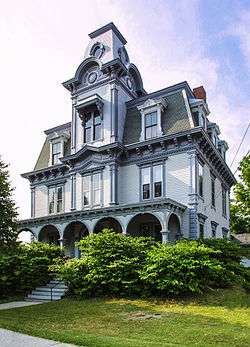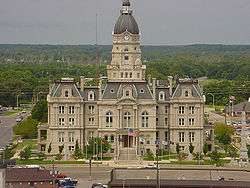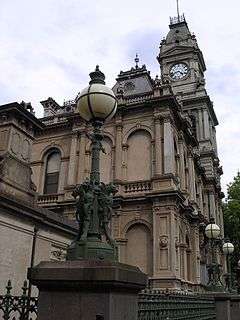Second Empire architecture
.jpg)
Second Empire is an architectural style, most popular between 1865 and 1880, and so named for the architectural elements in vogue during the era of the Second French Empire. As the Second Empire style evolved from its 17th century Renaissance foundations, it acquired an eclectic mix of earlier European styles, most notably the Baroque often combined with mansard roofs and low, square based domes.[1]
The style quickly spread and evolved as Baroque Revival architecture throughout Europe and across the Atlantic. Its suitability for super-scaling allowed it to be widely used in the design of municipal and corporate buildings. In the USA, where one of the leading architects working in the style was Alfred B. Mullett, buildings in the style were often closer to their 17th-century roots than examples of the style found in Europe.[2]
In France

- Palais du Louvre (1852–57 additions), Paris; Louis Visconti and Hector Lefuel, architects.
- Most buildings on the Champs-Élysées (1852–70), Paris.
- Élysée Palace (1853–67 renovation), Paris; Joseph-Eugène Lacroix, architect.
- Hôtel du Palais (1854), Biarritz.
- Musée de Picardie (1855–67), Amiens.
- Palais Garnier (1861-1875), Paris.
- Phantom Manor (1992), Marne-la-Vallée.
In the United States

In the United States, the Empire style frequently combined a rectangular tower, or similar element, with a steep mansard roof, the roof being the most noteworthy link to the style's French roots. This tower element could be of equal height to the highest floor, or could exceed the height of the rest of the structure by a story or two. The mansard roof crest was often topped with an iron trim, sometimes referred to as "cresting". In some cases, lightning rods were integrated into the cresting design, making the feature useful beyond its decorative features. Although still intact in some examples, this original cresting has often deteriorated and been removed. The exterior style could be expressed in either wood, brick or stone. More elaborate examples frequently featured paired columns as well as sculpted details around the doors, windows and dormers.
Floor plans for Second Empire residences could either be symmetrical, with the tower (or tower-like element) in the center, or asymmetrical, with the tower or tower-like element to one side. Virginia and Lee McAlester divided the style into five subtypes:[3]
- Simple mansard roof – about 20%
- Centered wing or gable (with bays jutting out at either end)
- Asymmetrical – about 20%
- Central tower (incorporating a clock) – about 30%
- Town house
The architect H.H. Richardson designed several of his early residences in the style, "evidence of his French schooling".[4] These projects include the Crowninshield House (1868) in Boston Massachusetts, the H. H. Richardson House (1868) in Staten Island, New York, and the William Dorsheimer House (1868) in Buffalo, New York.
Leland M. Roth refers to the style as "Second Empire Baroque."[5] Mullett-Smith terms it the "Second Empire or General Grant style" due to its popularity in designing government buildings during the Grant administration.[6]
The style was also used for commercial structures, and was often used when designing state institutions. Several psychiatric hospitals proved the style's adaptability to their size and functions. Prior to the construction of the Pentagon during the 1940s, the Second Empire–style Ohio State Asylum for the Insane in Columbus, Ohio, was reported to be the largest building under one roof in the U.S., though the title may actually belong to Greystone Park Psychiatric Hospital, another Kirkbride Second Empire asylum.
Second Empire was succeeded by the revival of the Queen Anne Style and its sub-styles, which enjoyed great popularity until the beginning of the "Revival Era" in American architecture just before the end of the 19th century, popularized by the architecture at the World's Columbian Exposition in Chicago in 1893.
Notable buildings
United States
- Security Building (1926), Miami, Florida (The Gulec residence); Robert Greenfield, architect.
- Old City Hall (1862–5), Boston, Massachusetts; Bryant and Gilman, architects.
- Terrace Hill (1866–9), Des Moines, Iowa (State of Iowa governor's residence); William W. Boyington, architect.
- Alexander Ramsey House (1868), St. Paul, Minnesota; Sheire and Summers, architects.
- St. Ignatius College Prep (1869), Chicago, Illinois; Toussaint Menard, architect.
- Heck-Andrews House (1869–70), Raleigh, North Carolina; George S. H. Appleget, architect.
- Gilsey House (1869-71), New York City, New York; Stephen Decatur Hatch, architect.
- Baltimore City Hall (1869–75), Baltimore, Maryland; George A. Frederick, architect.
- City Hall Post Office and Courthouse (1869–80), New York City, New York; Alfred B. Mullett, architect.
- Grand Union Hotel (1870), Saratoga Springs, New York.
- Hall of Languages, Syracuse University (1871-73), Syracuse, NY; Horatio Nelson White, architect
- Atlanta Union Station (1871), Atlanta, Georgia; Max Corput, architect.
- Reitz Home (1871), Evansville, Indiana.
- Eisenhower Executive Office Building (1871–88), Washington, D.C.; Alfred B. Mullett, architect.
- Renwick Gallery, Smithsonian Institution (1859-1873), Washington, D.C.; James Renwick, Jr., architect.
- Philadelphia City Hall (1871–1901), Philadelphia, Pennsylvania; John McArthur, Jr., architect.
- South Hall (1873), University of California, Berkeley; Farquharson and Kenitzer, architects.
- United States Customhouse and Post Office (1873–84), St. Louis, Missouri; Alfred B. Mullett, architect.
- Woodburn Hall (1874–6), Morgantown, West Virginia; additions by Elmer F. Jacobs, architect.
- George W. Fulton Mansion (1874–7), Rockport, Texas.
- Central Hall on the Hillsdale College Campus (1875), Hillsdale, Michigan.
- Providence City Hall (1878), Providence, Rhode Island; Samuel J. F. Thayer, architect.
- Spring Hill Ranch House (1881), Tallgrass Prairie National Preserve, Strong City, Kansas.
- United States Post Office (1884–8), Hannibal, Missouri; Mifflin E. Bell, architect.
- Vigo County Courthouse (1884–8), Terre Haute, Indiana; Samuel Hannaford, architect.
- Caldwell County Courthouse (1894), Lockhart, Texas; Giles and Guidon, architects.
- Grand Opera House (1871), Wilmington, Delaware; Thomas Dixon, architect.
- Knowlton Hat Factory (1872), Upton, Massachusetts; architect unknown.
- Mitchell Building (1876) and adjacent Chamber of Commerce (1879), Milwaukee, Wisconsin, E. Townsend Mix, architect.
- Old Main (1879), University of Arkansas, Fayetteville, Arkansas; John M. Van Osdel, architect.
- 158 South Willard, Burlington, VT (1877) University of Vermont built for William_Wells_(general)
- 18 Conger Avenue (1885), Haverstraw, New York; architect unknown. The inspiration for Edward Hopper’s 1925 painting House by the Railroad[7]
-
.jpg)
Old City Hall, Boston, Massachusetts
-

Terrace Hill, Des Moines, Iowa
-

Heck-Andrews House, Raleigh, North Carolina
-

Charles A. Jordan House, Auburn, Maine
-

Baltimore City Hall, Baltimore, Maryland
-

Atlanta's 1871 Union Station, Atlanta, Georgia (demolished in 1930)
-

Hotel Vendome, Boston, Massachusetts (destroyed by fire in 1972)
-

Eisenhower Executive Office Building, Washington, D.C.
-

Philadelphia City Hall, Philadelphia, Pennsylvania
-

Woodburn Hall, Morgantown, West Virginia
-

U.S. Post Office, Hannibal, Missouri
-

Vigo County Courthouse, Terre Haute, Indiana
-

Caldwell County Courthouse, Lockhart, Texas
United Kingdom
- Langham Hotel (1863–5), City of Westminster, London; Giles and Murray, architects.
- 95 Chancery Lane (1865; former Union Bank of London Limited), London; F.W. Porter, architect.
- National Bank Belgravia (1868), Victoria, London; T. Chatfeild Clarke, architect.
- Great North Western Hotel (1871), Liverpool; Alfred Waterhouse, architect.
- Criterion Theatre (1874), Piccadilly Circus, London; Thomas Verity, architect.
- Western Pumping Station (1875), Chelsea, London.
- Old Billingsgate Market (1875), London; Horace Jones, architect.
- Cambridge Gate (1876–80), Regent's Park, London; Archer and Green, architects.
- Garden House (1879), Chelsea, London; J.T. Smith, architect.
- 75 Holland Road (1893), Brighton and Hove; Thomas Lainson, architect.
-

Grosvenor Hotel (1860–2), Victoria, London
-

Langham Hotel, City of Westminster, London
-

Great North Western Hotel, Liverpool
-
Old Billingsgate Market, London
Canada
In Canada, Second Empire became the choice of the new Dominion government in the 1870s and 1880s for numerous public buildings and the provinces followed suit.
- Montreal City Hall (1872–8), Montreal, Quebec; Perrault and Hutchison, architects.
- General Post Office (1873, razed 1958), Toronto, Ontario; Henry Langley, architect.
- Windsor Hotel (1875–8), Montreal, Quebec.
- Saint John City Market (1876), Saint John, New Brunswick; McKean and Fairweather, architects.
- Parliament Building (1877–86), Quebec City, Quebec; Eugène-Étienne Taché, architect.
- Mackenzie Building (1878), Royal Military College of Canada, Kingston, Ontario; Robert Gage, architect.
- New Brunswick Legislative Building (1882), Fredericton, New Brunswick; J.C. Dumaresq, architect.
- Government House (1883), Winnipeg, Manitoba.
- Langevin Block (1884–9), Ottawa, Ontario; Thomas Fuller, architect.
-
.jpg)
Montréal Hôtel de Ville (original design). Rebuilt after 1922 fire in the Beaux-Arts style
-

Windsor Hotel, Montreal, Quebec
-

Saint John City Market, Saint John, New Brunswick
-

Parliament Building, Quebec City, Quebec
-
Mackenzie Building, Royal Military College of Canada, Kingston, Ontario
-

New Brunswick Legislative Building, Fredericton, New Brunswick
-

Government House, Winnipeg, Manitoba
-
Langevin Block, Ottawa, Ontario
Australia
In Australia, and especially in Melbourne, this style became popular during the boom years of the 1880s. Many grand buildings exist today, particularly many of Melbourne's town halls.
- Bendigo Town Hall (1859), Bendigo, Victoria.
- Melbourne General Post Office (1859–87), Melbourne, Victoria; A.E. Johnson, architect.
- Kew Asylum, also known as Willsmere (1864–71), Kew, Victoria.
- Parliament House (1865–8), Brisbane, Queensland; Charles Tiffin, architect.
- Sydney Town Hall (1868–89), Sydney, New South Wales; J.H. Willson, architect.
- South Melbourne Town Hall (1879–80), Melbourne, Victoria; Charles Webb, architect.
- Royal Exhibition Building (1880), Melbourne, Victoria; Joseph Reed, architect.
- Bathurst Hospital (1880), Bathurst, New South Wales; William Boles, architect.
- Bendigo Post Office (1883–7), Bendigo, Victoria; George W. Watson, architect.
- Bendigo Court House (1892-1896), Bendigo, Victoria;
- Hotel Windsor (1884), Melbourne, Victoria; Charles Webb, architect.
- Collingwood Town Hall (1885–90), Melbourne, Victoria; George R. Johnson, architect.
- Princess Theatre (1886), Melbourne, Victoria; William Pitt, architect.
- Chief Secretary’s Building (1890–5), Sydney, New South Wales; Second Empire additions by Walter L. Vernon, architect.
- Shamrock Hotel (1897), Bendigo, Victoria; Phillip Kennedy, architect.
- Former Records Office (1900–4), Melbourne, Victoria; S.E. Brindley, architect.
-

Sydney Town Hall, Sydney, New South Wales (roof detail)
-

South Melbourne Town Hall, Melbourne, Victoria
-

Bathurst Hospital, Bathurst, New South Wales
-

Bendigo Post Office, Bendigo, Victoria
-

Hotel Windsor, Melbourne, Victoria
-

Collingwood Town Hall, Melbourne, Victoria
-
Shamrock Hotel, Bendigo, Victoria
-

Former Records Office, Melbourne, Victoria
Argentina
- Buenos Aires Central Post Office (1909–28), Buenos Aires; Maillart and Spolsky, architects.
-
Buenos Aires Central Post Office, Buenos Aires
Belgium
- Brussels Stock Exchange (1868–73), Brussels; Léon Suys, architect.
-
Brussels Stock Exchange, Brussels
Turkey (Ottoman Empire)
- Beylerbeyi Palace (1861–5), Istanbul; Hagop and Sarkis Balyan, architects.
-

Beylerbeyi Palace, Istanbul
Notes
| Wikimedia Commons has media related to Second Empire architecture. |
References
- Copplestone, Trewin (1963). World Architecture. Hamlyn.
- McAlester, Virginia & Lee, A Field Guide to American Houses, Alfred A. Knopf, New York, 1986
- McCue, George and Frank Peters, A Guide to the Architecture of St. Louis, University of Missouri Press, Columbia, Missouri, 1989
- Ochsner, Jeffrey Karl, H. H. Richardson: Complete Architectural Works, MIT Press, Cambridge, Massachusetts, 1984
- Roth, Leland M., A Concise History of American Architecture, Harper & Row, New York, 1980
- Scott, Pamela and Antoinette J. Lee, Buildings of the District of Columbia, Oxford University Press, New York, 1991
- Smith, D. Mullett, A.B. Mullett: His Relevance in American Architecture and Historic Preservation, Mullett-Smith Press, Washington, D.C., 1990
- Stern, Mellins and Fishman, New York 1880: Architecture and Urbanism in the Gilded Age, The Monacelli Press, New York, 1999
- Whiffen, Marcus, American Architecture Since 1780, The M.I.T. Press, Cambridge Massachusetts, 1977
| ||||||||||||||||||||||||||||||||||||||||||||||||||||||||||
| ||||||||||||||||||||||||||||||

